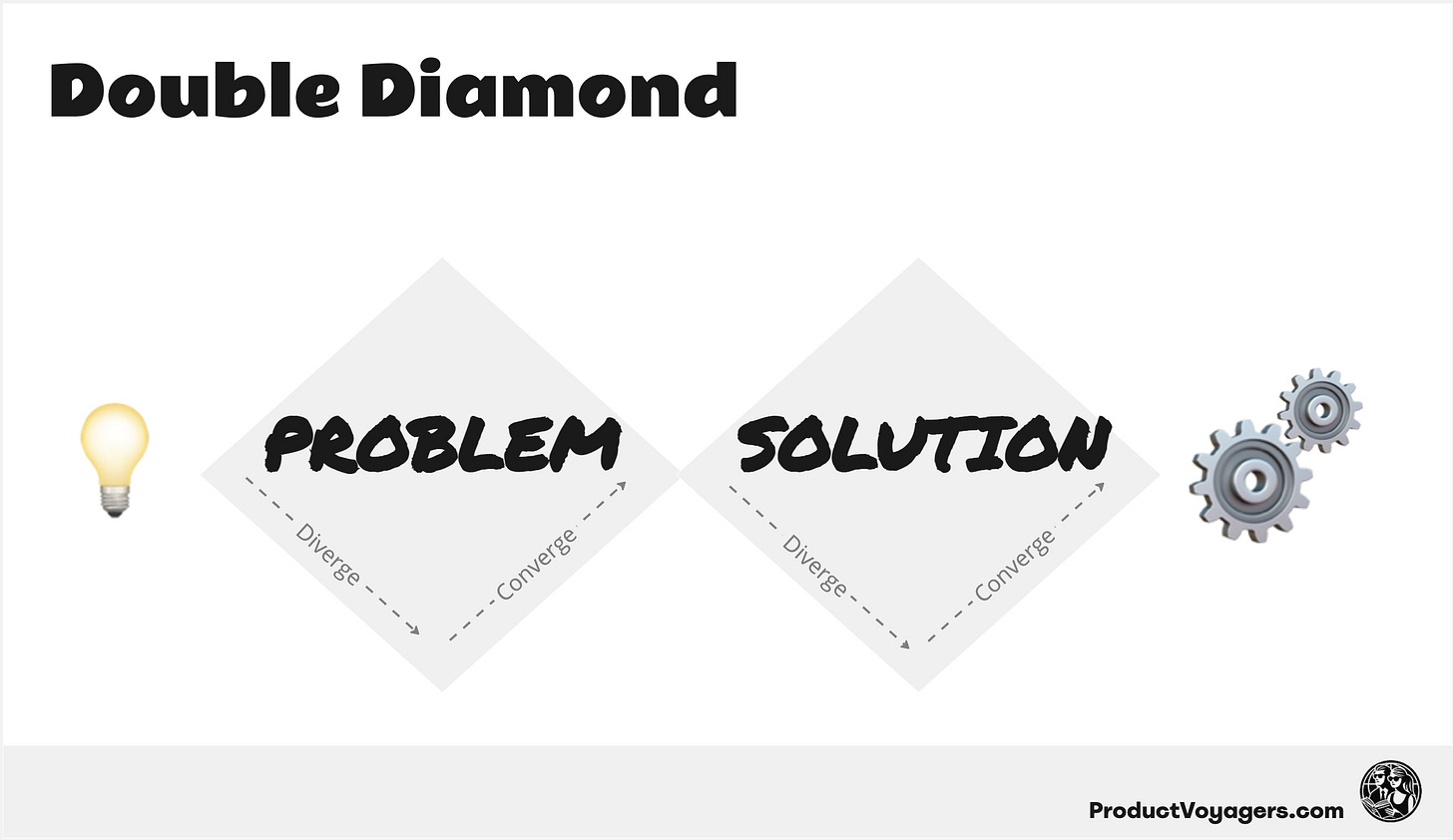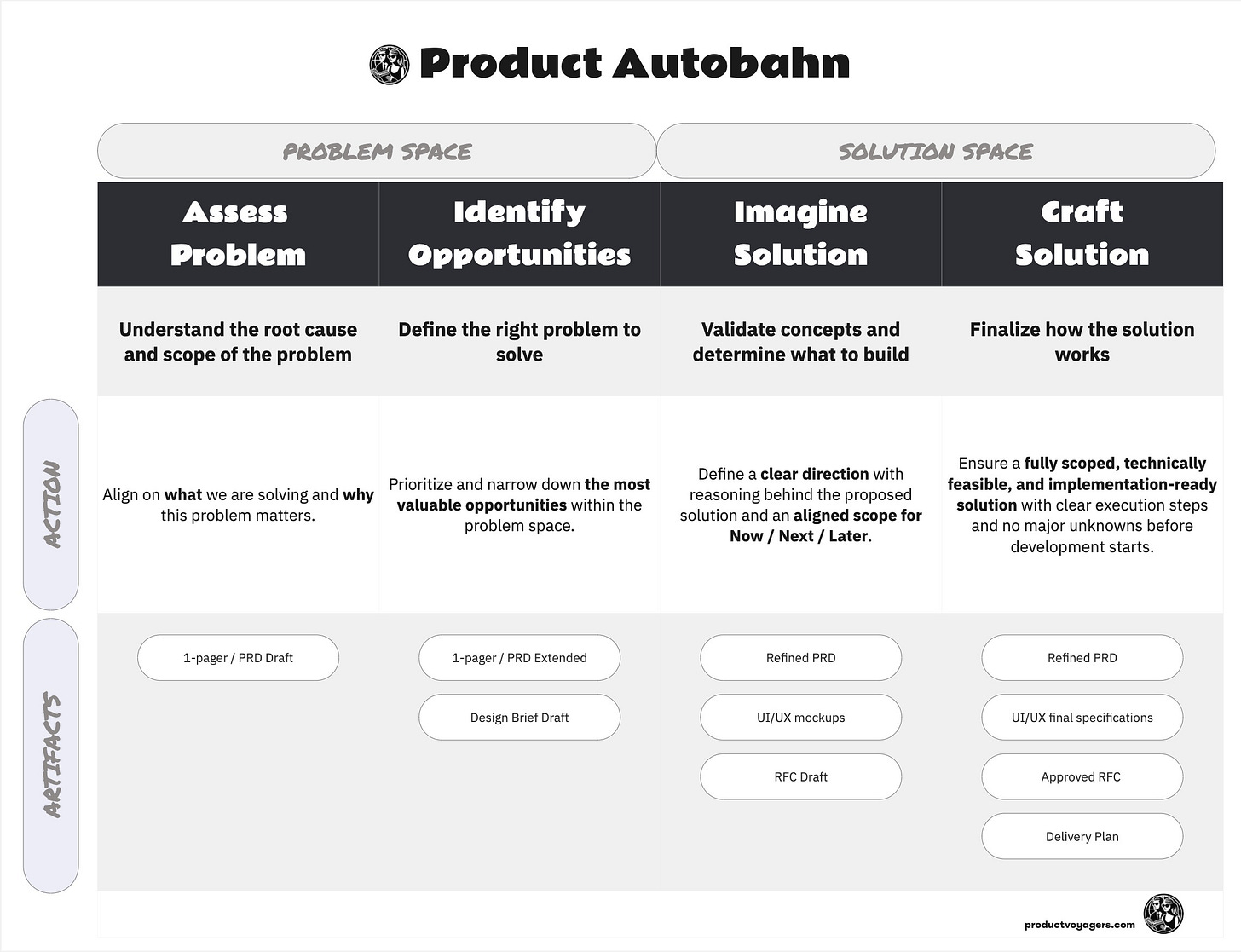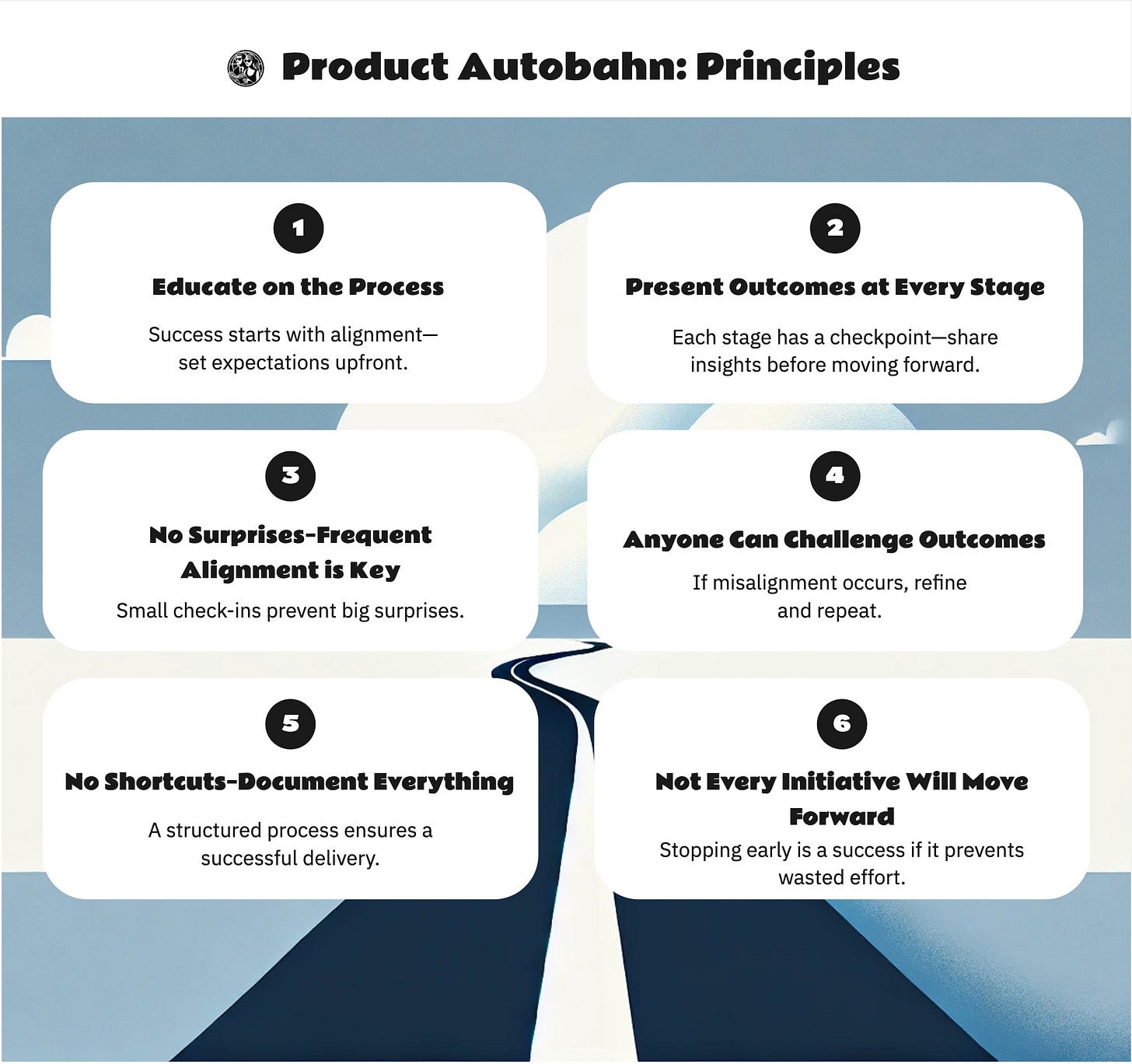Product Autobahn: A Structured Approach to Building Better Products
Too many teams rush to ship, only to realize they built the wrong thing. The Product Autobahn ensures structured decision-making, helping you move fast with confidence.
Product Managers often struggle to balance speed and alignment—delivering quickly while ensuring they’re solving the right problems. Whether you're a seasoned Product Leader or an individual contributor, you've probably faced situations where a feature didn’t land as expected, or a last-minute request disrupted your roadmap.
Over the past two years, Wafaey and I have worked closely with product teams—some that fully embraced a structured approach, and others that hesitated to enforce it. The difference was striking. Teams that followed the process delivered stronger products, avoided costly rework, and built confidence across stakeholders. Those that skipped steps or applied the framework inconsistently often struggled with misalignment, rushed solutions, and unclear decision-making.
This article breaks down a practical approach to product development, helping teams avoid these common pitfalls and move fast without losing clarity. We’ll explore:
✅ How to apply the Double Diamond framework in real-world product management.
✅ The Product Autobahn—a structured, step-by-step approach to execution.
✅ Practical principles to help you align teams and stakeholders at every stage.
By the end, you'll walk away with a repeatable process that helps you deliver impactful solutions while keeping teams and stakeholders aligned. And in the next article, we’ll go even deeper—covering concrete templates and examples to apply each phase of the Product Autobahn.
Real Stories of Product Misalignment (and What We Can Learn)
Whether you're leading a team of Product Managers or working as an individual contributor, you've likely experienced moments where a feature didn’t land as expected or a last-minute request disrupted the bigger picture. The following situations might feel all too familiar—so let’s dive in.
Situation 1:
It was time for a Product Review, and the team was excited to finally demo a new feature they had been working on—a custom pricing configuration for enterprise clients. This feature was identified as a critical gap, making it difficult for large clients to integrate with our system, and they had been waiting on it for months. The Product Manager felt a mix of excitement and nervousness as numerous stakeholders joined the meeting.
The team started the demo.
Ten minutes in, the questions began. Product and Engineering leads were puzzled by the complicated multi-step flow, wondering why this approach was chosen. Stakeholders, eager to use the feature, started asking, "How can I apply pricing rules across multiple regions?" and "Why can’t I override discounts for specific customer segments?" Their frustration grew as they realized the feature didn’t fully solve their needs.
The meeting dragged on longer than planned, and by the end, the excitement had faded. The room was left with confusion, frustration, and a clear sense that something had gone wrong.
Situation 2:
The team is presenting the results of the last two weeks during the Sprint Review. As you skim the board, you notice they worked on a completely new story: adding a "Buy Again" button for frequently purchased items on the product page. You don’t remember seeing this in the backlog.
You ask about it, and the Product Manager explains, “One of our commercial stakeholders requested it, and since it was a quick fix, we just did it.”
You dig deeper. "How does this interact with the personalized recommendations we’re rolling out next quarter?" The Product Manager pauses. They haven’t considered the connection at all.
At that moment, you realize the team just shipped a feature without validating whether it fits into the bigger picture.
🕵️ We All Know Where This Went Wrong
If you’ve been in product long enough, you’ve probably seen this play out more than once. Neither of these situations is unusual—they’re just part of the reality of building products in fast-moving organizations.
In Situation 1 (Product Review Misalignment):
The team focused on execution without validating the problem-solution fit.
Stakeholders only saw the feature when it was nearly done—too late for meaningful feedback.
Instead of excitement, the team faced confusion and frustration, realizing gaps they hadn’t considered.
In Situation 2 (Uncoordinated Work):
A small request was implemented in isolation without checking for alignment.
The Product Manager assumed a quick fix didn’t need broader validation.
The result? Potential duplication of work, inconsistent experiences, and wasted effort.
None of this is unusual. It happens when teams operate with a delivery-first mindset rather than an outcome-first approach. And while speed matters, moving fast without clarity only creates more work down the line.
🔹🔹 The Double Diamond Sounds Great—But How Do You Actually Use It?
You’ve probably heard of the Double Diamond framework. On paper, it sounds like a magical solution—one that helps you solve the right problems while delivering a ton of benefits:
Encourages Deep Problem Understanding - Prevents jumping to solutions too early by first exploring the problem space.
Balances Creativity & Focus - Ensures both exploration (divergence) and decision-making (convergence) are structured.
Reduces Risk of Building the Wrong Thing - Validates the problem and solution before investing in development.
Aligns Teams & Stakeholders - Provides a shared framework for cross-functional collaboration.
Supports Continuous Learning & Iteration - Enables iterative improvements based on user feedback and data.
Sounds great, right? And it is. But here’s the challenge—how do you actually apply it in day-to-day product work?
That’s exactly what we’re here to share. Over the past two years, we’ve worked directly with our product teams to integrate the Double Diamond into real-world processes—and helped others do the same. Whether you're in a large organization, a fast-moving startup, or a client-focused agency, this guide will show you how to bring the framework to life in a way that actually works.
🚘 From Idea to Execution: The Product Autobahn
We’ve broken down the Double Diamond into four key phases—each with clear actions, outcomes, and artifacts. When thinking about a name, Product Autobahn felt like the perfect fit.
Not just because we both live in Berlin, but also because the idea of divergence and convergence in problem-solving is a lot like driving on the Autobahn—Germany’s famously fast and structured highway system.
When you’re driving on the Autobahn, you need to make critical decisions early. If you miss an exit, you can’t just turn around—you have to go further down the road, sometimes miles, before you can correct your course.
Similarly, in product development, if you rush past problem exploration or alignment, you might realize too late that you're heading in the wrong direction. By then, the cost of course correction is much higher.
A well-planned Autobahn journey is about speed with control—you drive fast, but only because you have clear signposts, structured exits, and proper preparation. The same applies to building products: you can move fast, but only when each phase is well-structured and aligned.
One of the core principles of the Product Autobahn? You can’t move to the next phase until there’s alignment across cross-functional roles and stakeholders. This ensures that every step is deliberate and well-informed, reducing the risk of costly detours later.
We’ll dive deeper into these principles later, but first, let’s break down the four phases of any successful product initiative:
🚦 The 4 Phases of the Product Autobahn
🔍 #1 Assess Problem: Understand the root cause and scope of the problem
Action: Align on what we are solving and why this problem matters.
🎯#2 Identify Opportunities: Define the right problem to solve
Action: Prioritize and narrow down the most valuable opportunities within the problem space.
💡#3 Imagine Solution: Validate concepts and determine what to build
Action: Define a clear direction with reasoning behind the proposed solution and an aligned scope for Now / Next / Later.
🛠️ #4 Craft Solution: Finalize how the solution works
Action: Ensure a fully scoped, technically feasible, and implementation-ready solution with clear execution steps and no major unknowns before development starts.
The Product Autobahn lays the groundwork for better decision-making and structured execution. But what does it actually look like in practice?
In the next article, we’ll break down each phase of the Autobahn, including:
✅ Concrete templates to guide teams through the process.
✅ Examples of real product features at each phase.
✅ Common challenges and how to overcome them.
But before that, let’s deep dive into principles that will help you to ensure success.
Principles: How to Drive the Product Autobahn in Day-to-Day Product Management
Turning theory into action is where things get tricky. It’s not enough to introduce the Product Autobahn—you have to make sure teams actually follow it. And that starts with Product Leaders, Design Leaders, and Engineering Leaders acting as true advocates. They’re not just overseeing the process; they’re the driving force behind it.
One of the biggest reasons teams still end up shipping misaligned or half-baked products isn’t a lack of skill or effort. More often than not, it’s because leaders hesitate to fully enforce the process. They avoid making the hard call—deciding whether an initiative is ready to move forward or if the team needs to reassess and retry. They fear it will hurt team morale or shake individual confidence.
But when we compare teams that fully embrace this structured approach versus those who follow it sporadically, the difference is clear. The teams that live by this process build stronger products, avoid costly rework, and create an environment where alignment and confidence thrive.
So, what makes the difference? These six principles.
🚦 The 6 Core Principles of the Product Autobahn
#1 Educate on the Process
📌 "Success starts with alignment—set expectations upfront."
Before diving into the work, educate all stakeholders and teams (including Product, Design, Engineering, and Product Operations) on how the iterative approach works. Make it clear that every stage must be validated before moving forward to prevent rushed solutions and last-minute misalignment.
#2 Present Outcomes at Every Stage
📌 "Each stage has a checkpoint—share insights before moving forward."
After completing each phase, the outcomes must be formally presented. This isn’t limited to Product Managers—any team member (Designer, Engineer, Product Ops) can present, as long as they own the topic. A structured template ensures clarity, and stakeholders must sign off before moving forward.
#3 No Surprises—Frequent Alignment is Key
📌 "Small check-ins prevent big surprises."
Before transitioning to the next phase, schedule short (15-30 min) alignment meetings to confirm that everyone is on the same page. This prevents late-stage misalignment, reduces unnecessary rework, and ensures smooth execution.
#4 Iteration Over Assumption—Anyone Can Challenge Outcomes
📌 "If misalignment occurs, refine and repeat."
If stakeholders challenge the outcome of a phase, it’s a signal to revisit and refine—not a failure. Every phase is designed to be iterative, ensuring that the final solution is well-validated rather than rushed through.
#5 No Shortcuts—Document Everything
📌 "A structured process ensures a successful delivery."
Each stage has predefined templates (PRDs, RFCs, design briefs, etc.) that act as a living document. Skipping documentation creates misalignment, confusion, and execution gaps. If it’s not written down, it’s not truly aligned.
#6 Not Every Initiative Will Move Forward
📌 "Stopping early is a success if it prevents wasted effort."
At any stage—especially in the problem space—an initiative may be paused or discontinued if:
The problem isn’t a priority
The business impact is unclear
The solution is not feasible
Stopping before development starts is a win. It saves time, resources, and effort that can be redirected toward high-value, validated opportunities.
Why These Principles Matter
Following the Product Autobahn isn’t about slowing things down—it’s about avoiding costly mistakes. When teams operate with clear checkpoints, structured validation, and early alignment, they:
✅ Build solutions that actually solve the right problem
✅ Prevent rework and wasted development effort
✅ Move fast with confidence, not chaos
✅ Create stronger collaboration between Product, Design, and Engineering
It’s not about bureaucracy—it’s about clarity, speed, and execution excellence. 🚀
By now, you understand why structure matters in product development and how the Product Autobahn helps teams navigate uncertainty. But understanding the framework is just the beginning—the real challenge is applying it effectively.
In our next article, we’ll provide a deep dive into each phase, sharing:
📌 Step-by-step templates for each stage.
📌 Real-world feature examples to illustrate the process.
📌 Tips for overcoming common roadblocks.
This will be your go-to guide for making the Product Autobahn a reality in your team. Don’t miss it! 🚀






